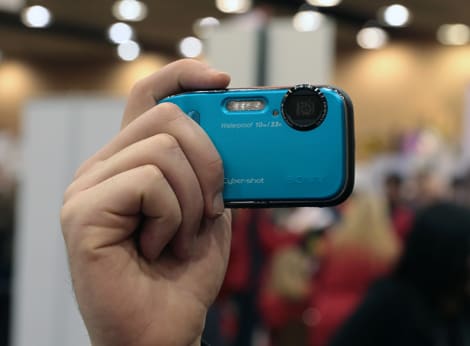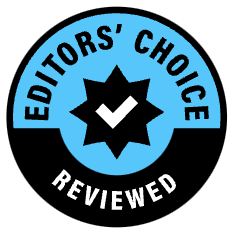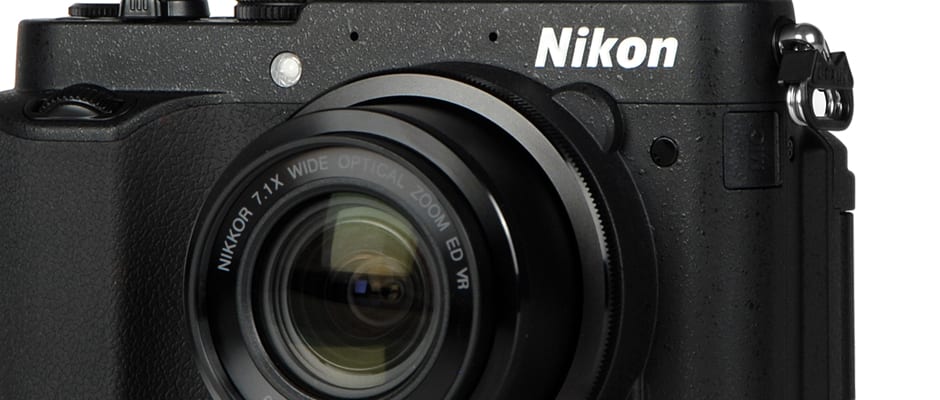Pros
Cons
Design & Usability
The P7700's physical design is remarkably similar to that of the P7100, minus the rather silly front dial that was basically unreachable on the earlier model. Instead, almost the entire area is freed up for grip, and the right-hand side of the front panel is coated completely with sticky rubberized material. This near-perfect (for a compact) ergonomic area, is interrupted only by the customizable Function button, which has been held over from the P7100, but is too shallow and too easy to press accidentally—plus, it's right in the way of the ring finger.
With the inclusion of this Function key, which is actually rather convenient once you become accustomed to it, you have near-complete control of the camera with just one hand. The command dial is ideally placed to the left of the thumb rest, while the thumb rest itself is grippy and flanked by a large protruding lip for extra leverage. There are three dials on the top panel, one for modes, one for exposure compensation, and one for quick access to common options—again, just like the P7100—with stops for ISO, white balance, etc. At the center of this last dial is a button that opens up the submenu for the setting you've already selected. If this third dial reminds you of Nikon's DSLR control scheme, it should.
In fact the whole camera handles in an extremely satisfying way, thanks to a slew of mechanical and "hold to adjust" controls. The P7700 is just a ton of fun to operate.
{{photo_gallery "FI Front Photo", "FI Back Photo", "FI Left Photo", "FI Right Photo", "FI Top Photo", "FI Bottom Photo", "FI Lens Photo", "FI Lens Mount Photo", "FI Viewfinder Photo", "FI LCD Photo", "FI Flash Photo", "FI Battery Photo", "FI Media Photo", "FI Ports Photo 1", "FI Ports Photo 2", "FI Handling Photo 1", "FI Handling Photo 2", "FI Ease OF Use Photo", "FI Auto Mode Photo", "FI Manual Controls Photo"}}
Features
{{section_header}}{{section.name}}{{/section_header}}
One of the key downsides of the P7100 was its sensor, which measured only 1/1.7-inch, had a resolution of only 10.1 megapixels, and used CCD technology, which is generally accepted as inferior (for most purposes—don't tell Leica M9 owners) to the newer CMOS standard. It made the P7100 seem like a trick, rather than a feat of engineering. Sure the camera handled like an enthusiast model, but you can only get so far with a point-and-shoot sensor.
The P7700 remedies this to a certain extent. The new sensor is CMOS-type, and resolution has been upped to 12 megapixels, but its size is still 1/1.7-inch—larger ones are apparently reserved for Nikon's 1-series interchangeable lens models. The small sensor comes as a disappointment here at the top of Nikon's fixed-lens lineup after Sony managed to squeeze a 1-inch sensor into their RX100, and especially considering the P7700's brand new lens.
Big changes have been made to the P7700's lens over one found on the P7100. The maximum aperture has been brightened way up to f/2.0, and even at maximum zoom the iris stays pretty wide at f/4.0. The result is far more bokeh than the P7100 was ever capable of, but the truth is, attractive backgrounds are a function of both the lens and the sensor. Out-of-focus areas are therefore better only in quantity, not quality, producing shots that are outstanding for a compact but worse than any SLR lens/sensor combo.
Less exciting but equally important is a new neutral density filter, which is helpful for outdoor photography or other situations where there's too much light for the camera's 1/4000-second maximum shutter speed to cope. The speed of the new lens gives this feature relevancy, since it allows the aperture to stay wide open in bright daylight without causing overexposure.

Conclusion
{{section_header}}{{section.name}}{{/section_header}}
Photokina is a long show, and at the risk of backing ourselves into a corner for First Impressions that are still to come, the Nikon P7700 seems to be one of the many, many cameras falling under the umbrella of "not as good as the RX100." But it's not like the P7700 seems like a bad camera, in fact it looks like an excellent one. If Sony hadn't fit near-DSLR-caliber image quality into an ultracompact earlier this year, we probably would've been impressed by a lot more high-end compacts. But without a noteworthy sensor, the P7700 actually competes more directly with the S110 or G15, rather than the G1 X or the RX100.
Where the P7700 does compete with the RX100, and in fact surpasses it entirely, is manual control. Many cameras in this price range offer the same flexibility, but the P7700's control scheme is much more mechanical, much more tactile, and much more fun. So although you won't be getting the absolute best image quality available in a fixed-lens camera, you will be enjoying one of the more satisfying user experiences in this segment. If you're interested in the P7700, have a conversation with yourself: is the final image more significant to you, or is the process and experience of photography most important?
As for us, we think the P7700 is stuck between a rock and a hard place, and are anxious to see how it performs in the marketplace.
Introduction
Remember when the camera market was cleanly divided? Fixed-lens for amateurs, interchangeable lens for enthusiasts and above. That's hardly the case anymore and, recognizing the existence of an "in-between" audience, one of the new ways Nikon competes with Canon is their P-series of advanced compacts. And just after Canon announced the new G15, so too did we finally get our hands on Nikon's Coolpix P7700, successor to the very popular P7100.
Specs
{{manufacturer_specs_table}}
Meet the tester
Chris was born and raised less than ten miles from our editorial office, and even graduated from nearby Merrimack College. He came to Reviewed after covering the telecom industry, and has been moonlighting as a Boston area dining critic since 2008.
Checking our work.
Our team is here to help you buy the best stuff and love what you own. Our writers, editors, and experts obsess over the products we cover to make sure you're confident and satisfied. Have a different opinion about something we recommend? Email us and we'll compare notes.
Shoot us an email


